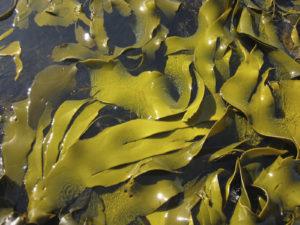 Seaweed: why would you? You may well ask, but people have been eating certain seaweeds since the dawn of time – there’s a lot of the stuff been found in fossils proving how long it’s been gracing the world’s seas. It’s a regular element in some cuisines especially in Asia. In Japan sheets of dried seaweed are used to wrap sushi and you may be familiar with crispy fried seaweed from your local Chinese takeaway.
Seaweed: why would you? You may well ask, but people have been eating certain seaweeds since the dawn of time – there’s a lot of the stuff been found in fossils proving how long it’s been gracing the world’s seas. It’s a regular element in some cuisines especially in Asia. In Japan sheets of dried seaweed are used to wrap sushi and you may be familiar with crispy fried seaweed from your local Chinese takeaway.
However, it can easily be used in many other recipes, from salads to soups. A coastal visit in the UK can yield enough of the ingredient to use if you fancy a bit of foraging. Edible seaweeds are nutritious vegetables – so packed full of vitamins and minerals that they are even being used for skincare products, so they can be good for you on the inside and the outside. Some edible seaweeds: Bladderwrack, Irish moss, Kombu, Laver, Nori, Sea lettuce, Sugar kelp, and Wakame.
The Cornish Seaweed Company is run by friends Caroline and Tim who aim to supply sustainably harvested, local, edible seaweeds as an alternative food source that is as healthy as it is tasty. They say, “We really hope and believe that seaweed becomes part of everyone’s diet and that we come to recognize it for what it is. A superfood, both environmentally and nutritionally!”
You can buy dried seaweed, sea salt as well as a range of skincare products from their website. The Cornish Seaweed Company
NUTRITION: Seaweed contains all the minerals that our bodies need and has the highest number of vitamins, minerals and trace elements of any other food group. It has played a vital part in the diets of a large number of cultures, including the Inuit, Japanese, Incas and the Irish. The Inuit get all their vitamin C from seaweeds.
 Kombu (or kelp) crisps
Kombu (or kelp) crisps
Kombu (a member of the Kelp family) is probably most well known for the unique effect it has on the taste buds, that which the Japanese call Umami and what we know in the west as our fifth flavour or simply savoury. Kombu is a very versatile seaweed which adds vitamins and minerals to any dish. It is used to make broths and serves as a base ingredient in stocks (such as dashi used in miso soup). We’re told these go hand in hand with a good pint of bitter or a shot of whiskey on a cold winter night and we’ve never seen a simpler recipe.
Ingredients
Dried Kombu
Instructions
1. Rinse the Kombu in cold water, then soak it for 5-10 minutes in tepid fresh water.
2. Cut into the size you want your crisps to be. Place on a baking tray on grease proof paper if you have some.
3. Bake for approximately 10 minutes, until crisp.
4. Serve hot or cold
This news item first appeared in Desang Diabetes Magazine, our free-to-receive digital journal. We cover diabetes news, diabetes management equipment (diabetes kit) and news about food suitable for a diabetic diet. Go to the top of this page to sign up – we just need your email address.



